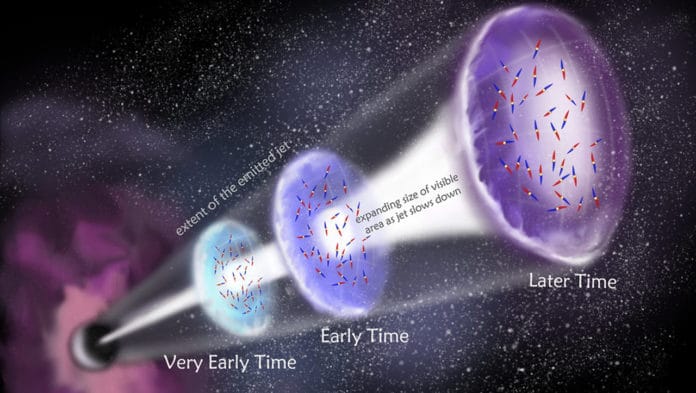Using Good fortune and cutting-edge scientific instruments, scientists observed a Gamma Ray Burst jet and detected the polarisation of radio waves within it for the first time. According to scientists, their finding offers detail insights on what causes the universe’s most powerful explosions.
Gamma-ray bursts (GRBs) are extremely energetic explosions that have been seen in distant galaxies. They are the brightest electromagnetic events known to happen in the universe. Bursts can last from ten milliseconds to several hours. After the first flash of gamma rays, a longer-lived ‘afterglow’ is typically radiated at longer wavelengths.
Studying the light from Gamma Ray Burst as it travels across space is the possible way to get detail insights on the formation of these powerful jets. For this, scientists need to be quick to get their telescopes into position and get the best data. The detection of polarised radio waves from a burst’s jet, made possible by a new generation of advanced radio telescopes, offers new clues to this mystery.
The light from this particular event, known as GRB 190114C, which exploded with the force of millions of suns’ worth of TNT about 4.5 billion years ago, reached NASA’s Neil Gehrels Swift Observatory on Jan 14, 2019.
A rapid alert from Swift allowed the research team to direct the Atacama Large Millimeter/Sub-millimeter Array (ALMA) telescope in Chile to observe the burst just two hours after Swift discovered it. Two hours later the team was able to observe the GRB from the Karl G. Jansky Very Large Array (VLA) telescope when it became visible in New Mexico, USA.
Combining the measurements from these observatories allowed the research team to determine the structure of magnetic fields within the jet itself, which affects how the radio light is polarised. Theories predict different arrangements of magnetic fields within the jet depending on the fields’ origin, so capturing radio data enabled the researchers to test these theories with observations from telescopes for the first time.
Scientists discovered that only 0.8% of the jet light was polarised, meaning that jet’s magnetic field was only ordered over relatively small patches – each less than about 1% of the diameter of the jet. Larger patches would have produced more polarised light.
The study suggests that Scientists discovered that only 0.8% of the jet light was polarised, meaning that jet’s magnetic field was only ordered over relatively small patches – each less than about 1% of the diameter of the jet. Larger patches would have produced more polarised light.
These measurements suggest that magnetic fields may play a less significant structural role in GRB jets than previously thought.
This helps us narrow down the possible explanations for what causes and powers these extraordinary explosions.
First author Dr Tanmoy Laskar, from the University of Bath’s Astrophysics group, said: “We want to understand why some stars produce these extraordinary jets when they die, and the mechanism by which these jets are fuelled – the fastest known outflows in the universe, moving at speeds close to that of light and shining with the incredible luminosity of over a billion suns combined.
“I was in a cab on my way to O’Hare airport in Chicago, following a visit with collaborators when the burst went off. The extreme brightness of this event and the fact that it was visible in Chile right away made it a prime target for our study, and so I immediately contacted ALMA to say we were going to observe this one, in the hope of detecting the first radio polarisation signal.
“It was fortuitous that the target was well placed in the sky for observations with both ALMA in Chile and the VLA in New Mexico. Both facilities responded quickly, and the weather was excellent. We then spent two months in a painstaking process to make sure our measurement was genuine and free from instrumental effects. Everything checked out, and that was exciting.”
Dr. Kate Alexander, who led the VLA observations, said: “The lower frequency data from the VLA helped confirm that we saw the light from the jet itself, rather than from the interaction of the jet with its environment.”
Dr. Laskar added: “This measurement opens a new window into GRB science and the studies of energetic astrophysical jets. We would like to understand whether the low level of polarisation measured in this event is characteristic of all GRBs, and if so, what this could tell us about the magnetic structures in GRB jets and the role of magnetic fields in powering jets throughout the universe.”
Professor Carole Mundell, Head of Astrophysics at the University of Bath, added: “The exquisite sensitivity of ALMA and rapid response of the telescopes has, for the first time, allowed us to swiftly and accurately measure the degree of polarisation of microwaves from a GRB afterglow just two hours after the blast and probe the magnetic fields that are thought to drive these powerful, ultrafast outflows.”
The research team plans to hunt for more GRBs to continue to unravel the mysteries of the biggest explosions in the universe.
The study “ALMA detection of a linearly polarized reverse shock in GRB 190114C” is published in Astrophysical Journal Letters.
